20 Low Light Succulents For Indoor Spaces
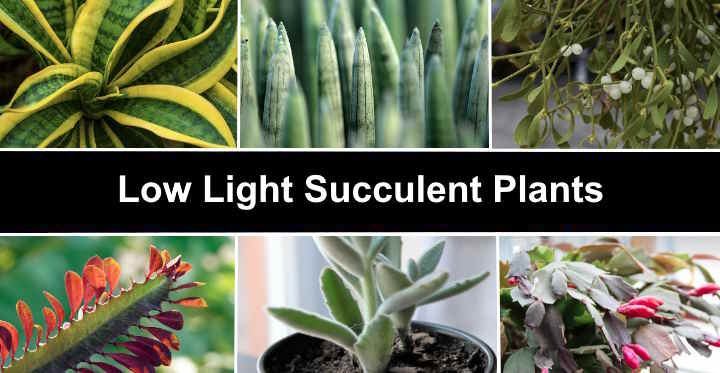
Low-light succulents are ideal indoor plants where rooms have poor lighting conditions. Succulents that grow in partially shaded conditions allow you to add greenery to indoor spaces despite a lack of sunshine or bright light. Shade-tolerant succulents include echeveria, mistletoe cactus, snake plants, and Christmas cactus. Some trailing low-light succulents like Burro’s tail and wax plants are ideal for hanging baskets.
Of course, all plants need a level of light to photosynthesize and grow. However, rooms with north-facing windows, apartments in the shadows of taller buildings, or dim areas may lack the sufficient light most succulents need. Thankfully, many succulents thrive in low-light conditions.
This article lists the top succulents that grow well in low light. Pictures and descriptions of the low-light, thick, fleshy plants will help you decide which ones are suitable for your indoor space.
How Much Light Do Low Light Succulents Need?
Low-light succulents thrive in environments where natural light or direct sunlight is limited. In some cases, they can survive in bright, indirect light, partial shade, or filtered light. In the case of extremely dim rooms, you may need to use grow lights to ensure the succulents remain healthy.
Here are some guidelines on how much brightness low-light succulents need to thrive.
Bright, indirect light: Many low-light succulents perform best in bright, indirect light and have some shade tolerance. This location could be near a sunny window but behind a sheer curtain for protection from direct sunlight.
Low light: Plants on a north-facing windowsill may only get an hour or two of sunlight daily. Therefore, you should choose shade-tolerant succulents for these dim conditions. However, placing succulents at an east or west-facing window will provide bright light in the morning or afternoon.
Filtered light: This type of light level is where the room is bright for most of the day but filtered by blinds, curtains, or trees outside. You can also achieve filtered light by keeping the plant away from the window or at the back of a room.
Artificial lighting: You can use LED grow lamps to increase light intensity in rooms without sufficient sunlight. These lights contain a spectrum of light similar to natural sunlight. Generally, it would be best to keep the lights about 6” to 12” (15 – 30 cm) above the plants for the best results.
Duration of light exposure: It’s vital to consider the length of exposure as well as the intensity. Plants, including low-light succulents, grow best with a consistent light schedule that mimics daylight hours.
Although succulents are generally able to tolerate lower light conditions, it is crucial to monitor their growth. Look for signs of color loss, wrinkled leaves, sparse foliage, or poor growth. These signs could indicate that the plant requires more light. Moving it to a brighter location or using artificial lights can ensure it gets adequate light to thrive.
Best Low-Light Succulents
Let’s look in detail at some of the best low-light succulents that are perfect for indoor spaces with limited sunlight:
Snake Plant (Dracaena trifasciata)

Snake plants are one of the most popular houseplants for low-light conditions. These hardy, low-maintenance succulents can thrive in little sunlight and water. The plant is known for its characteristic long, flat, and sword-shaped leaves growing in a rosette form. The leaves are typically dark green with yellow margins.
Also called mother-in-law’s tongue or viper’s bowstring, the evergreen perennial can grow up to 3 ft. (0.9 m) tall. The mature leaves typically have dark green, mottled patterns contrasting with yellow edges. Its tolerance for low light levels and minimal care make it an easy houseplant for beginners.
Snake plants can flourish in most indoor environments. They perform just as well on a sun-bathed windowsill or a dimly lit nook in your home. Snake plants can also go for weeks without any water. Therefore, they are ideal for adding greenery to secluded corners in your home.
According to NASA research, Dracaena trifasciata has air-purifying properties. The plant can help reduce levels of indoor air pollutants like benzene and formaldehyde.
- Plant Size: 1 to 3 ft. (0.3 – 0.9 m) tall
- Watering Needs: Rarely
- Sun Exposure: Partial shade
Cylindrical Snake Plant (Sansevieria cylindrica or Dracaena angolensis)
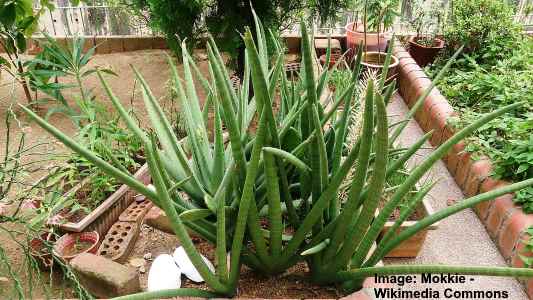
Cylindrical snake plant is a type of sansevieria succulent that adapts well to low-light conditions. The unique houseplant is known for its upward-pointing cylindrical, spear-like leaves. The round, succulent leaves grow up to 7 ft. (2.1 m) tall and 1” (2.5 cm) in diameter. The cylindrical leaves grow in a fan shape.
Because they require little sunlight, cylindrical snake plants are ideal for north-facing rooms or areas of your home with little or no natural light. The long, round, pointed leaves grow in a tight cluster, giving it a distinct, modern look. The leaves are typically dark green with light green banding or variegation.
Also called African spear, spear sansevieria, or Brazil Saint Barbara sword, the shade-tolerant succulent is low-maintenance, surviving with minimal water and sunlight. Although it can grow over 6 ft. (1.8 m) tall, its slow growth means it never gets that tall indoors. They are perfect for adding a touch of greenery to bedrooms, dimly lit rooms, or offices.
- Plant Size: Up to 3 ft. (0.9 m) tall
- Watering Needs: Once every two or three weeks in the growing season
- Sun Exposure: Low light to indirect sunlight
Lace Aloe (Aristaloe aristata)
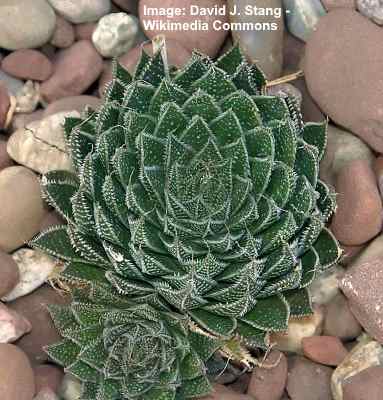
Also called the torch plant, lace aloe is a stunning shade succulent plant with white-spotted, dark green, pointed leaves. This beautiful aloe plant features rosettes of fleshy, lance-shaped leaves with stuffed tips and soft, spiny margins. Its low growth and attractive succulent rosettes make it an ideal indoor plant for shaded corners.
Shade-tolerant lace aloe can grow up to 12” (30 cm) tall; however, it usually stays as a small potted houseplant. The lacy foliage with silvery speckles forms beautiful, eye-catching rosettes. They also help brighten rooms with little direct sunlight. Additionally, lace aloe is a drought-tolerant plant requiring infrequent watering.
It is best to allow the soil to dry out completely between waterings to prevent root rot. Although it can tolerate shade, lace aloe performs well in bright, indirect sunlight. With its unique foliage and low-maintenance care requirements, lace aloe is an excellent choice for beginner and experienced plant enthusiasts.
- Plant Size: 8” to 12” (20 – 30 cm) tall and wide
- Watering Needs: Whenever the top 2” (5 cm) of soil is dry
- Sun Exposure: Bright, indirect sunlight, partial shade, low light
Echeveria Succulents

Most types of Echeveria succulents tolerate shade if you don’t water them too much. Echeverias are known for their fleshy leaves growing in tight rosettes. They range in size and color, making them versatile succulents for indoor shade gardens. Echeveria succulents also produce attractive flowers on tall stalks rising above the brightly colored leaves.
Native to Mexico and South America, echeveria succulents are low-light tolerant plants that thrive with minimal water. Their easy-care nature makes them ideal houseplants for bright or partly shaded rooms. The leaves typically grow in a saucer-shaped rosette pattern.
Types of shade-tolerant echeveria varieties include the following:
Echeveria lindsayana: This stunning shade succulent has bright, bluish-green fleshy leaves with red tips.
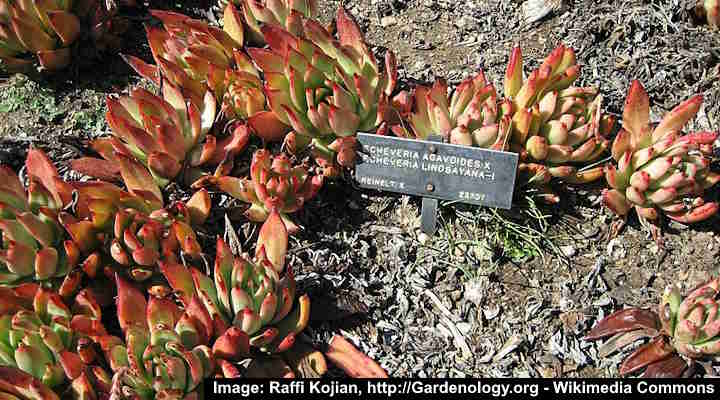
Echeveria lindsayana
Echeveria potosina: Ideal for partial shade, this succulent has fleshy, triangular leaves in blue-green colors with a waxy coating. The rosettes grow 6” (15 cm) wide.
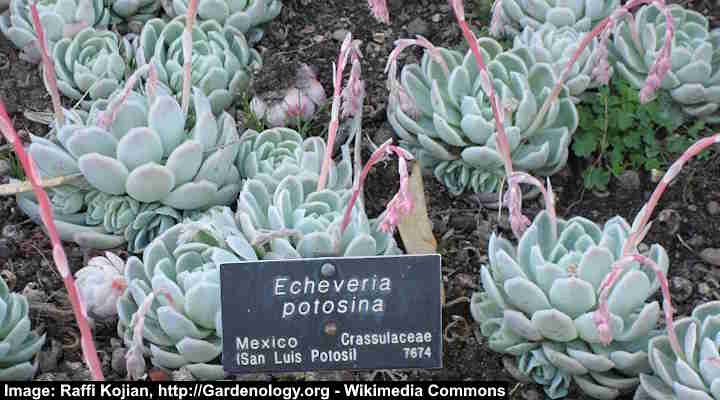
Echeveria potosina
Blue Rose (Echeveria ‘Imbricata’): Suitable for bright light or partial shade, this echeveria has blue-green leaves growing in a tight rosette. It grows up to 8” (20 cm) tall and 6” (15 cm) wide.
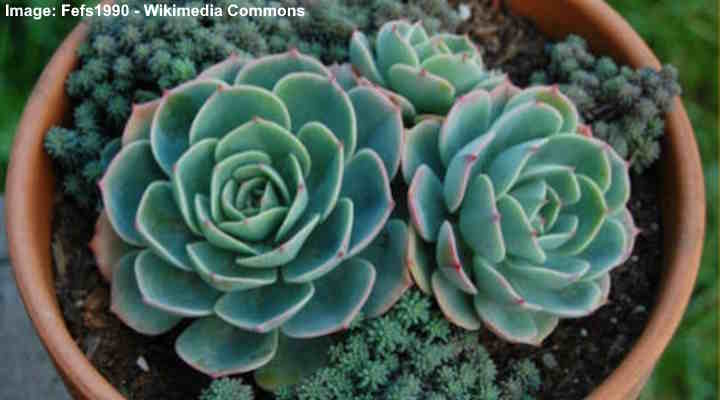
Blue Rose (Echeveria ‘Imbricata’)
It’s good to note that most echeveria varieties grow in bright, indirect light. The shade-tolerant succulents tend to have lighter leaves than those with dark-colored foliage.
- Plant Size: Varies depending on species, typically 2” to 12” (5 – 30 cm) tall
- Watering Needs: Infrequent; allow the soil to dry out entirely between waterings
- Sun Exposure: Bright, indirect light; some are tolerant of partial shade
Mistletoe Cactus (Rhipsalis baccifera)

Mistletoe cactus is a type of epiphytic cactus that grows in filtered shade and indirect light. The unusual tropical plant has long, trailing, thread-like cylindrical stems forming a bushy mound of cascading foliage. The cactus plant also produces small, white, berry-like fruits like mistletoe fruits.
Unlike most types of cacti, the mistletoe cactus is more succulent in nature and performs poorly in direct sunlight. Although it can tolerate some bright light, its native Central and South America habitat is under the forest canopy. This makes it ideal for growing indoors in lower light conditions.
- Plant Size: Up to 6 ft. (1.8 m) long and 2 ft. (0.6 m) wide
- Watering Needs: Regular watering to keep the soil evenly moist
- Sun Exposure: Dappled shade or indirect light
Ox Tongue Plant (Gasteria)

Ox tongue plants are a type of succulent similar in appearance to aloe vera plants. These plants are identified by their thick, tongue-shaped leaves with a slightly rough texture. The leaves can be a dark green, almost black color, and are often mottled with white spots or stripes.
Ox tongue plants are versatile succulents that adapt well to bright shade or indirect sunlight. When growing in a shady spot, it’s vital to water the succulents sparingly, allowing the soil to dry out between waterings.
Ox tongue plants are slow-growing, compact succulents, making them a great choice for small spaces or as part of a succulent arrangement. They are also known for producing tall spikes of tubular flowers in shades of pink, red, or orange.
- Plant Size: Compact, usually less than 1 ft. (0.3 m) tall
- Watering Needs: Sparingly, allow soil to dry out between waterings
- Sun Exposure: Bright, indirect sunlight, light shade
Panda Plant (Kalanchoe tomentosa)
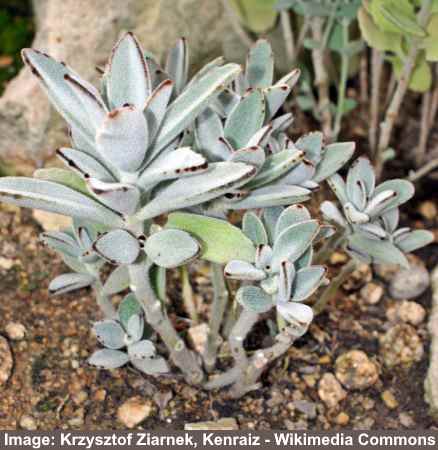
Also known as pussy ears, panda plants have fuzzy leaves that grow well in partial shade. The easy-grow, resilient succulent leaves resemble furry panda ears. The silvery-green fleshy leaves are 3” (7.5 cm) long with brown stitching-like patterns along the margins. Panda ears sometimes bloom in summer with clusters of yellow-green flowers.
Panda plants thrive in bright light and need protection from direct sunlight. However, the succulent also grows in partial shade in dry soils. Their compact, easy-care nature makes them ideal for indoor shade gardens, succulent collections, or decorative houseplants.
- Plant Size: 12” to 24” (30 cm) tall
- Watering Needs: Infrequent watering only when the soil is dry
- Sun Exposure: Bright, indirect light or partial shade
African Milk Tree (Euphorbia trigona)
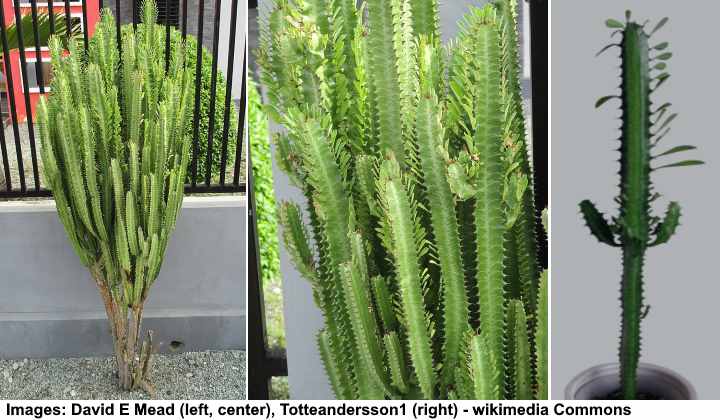
African milk tree is an unusual succulent with upward-growing cactus-like stems that tolerate some shade. The exotic houseplant has branches with two or three sides and V-shaped patterns. Also, the stems have thorns along the edges, making them visually attractive.
Also called the cathedral cactus, the African milk tree grows 12” to 24” (30 – 60 cm) as a potted houseplant. Although the best growth is in bright, indirect light, it can tolerate lower light conditions. However, you may find that too much shade causes it to lose its deep green color and upright habit.
The African milk tree only requires watering sparingly, and allowing the soil to dry out between waterings is vital. It’s good to note that the succulent stems emit a white latex sap—hence the name “milk tree.” This substance can cause skin irritation on contact.
- Plant Size: 1 to 2 ft. (0.3 – 0.6 m) tall
- Watering Needs: Sparingly, only when the top inch (2.5 cm) of soil is dry
- Sun Exposure: Bright, indirect light or partial shade
Bear Paw (Cotyledon tomentosa)

Bear paw is a cute, fuzzy succulent plant with fleshy leaves resembling soft bear paws. The wedge-like leaves have reddish tips that look like claws. These grow in low-growing clusters, creating a small, compact houseplant. Although bright, indirect sun is best, it can grow in lower-light environments or bright shade.
The bear paw plant is easy to care for indoors if you water it infrequently. The succulent plant also has a slow growth rate, only growing up to 6” (15 cm). The fuzzy leaves are gray-green with reddish tips, adding a unique and playful touch to any indoor space.
It’s good to note that too much shade can make the brownish claw-like tips lose their vibrancy. If that happens, move the plant to a brighter spot to improve its growth and rejuvenate the paw-like leaves.
- Plant Size: Up to 6” (15 cm) tall and 18” (45 cm) wide
- Watering Needs: Occasional watering when the top layer of soil is dry
- Sun Exposure: Bright, indirect light or partial shade
Flaming Katy (Kalanchoe blossfeldiana)

Also called the chandelier plant, flaming katy is a popular indoor flowering succulent plant that requires shade from direct sunlight. Identifying features of the shade-tolerant plant are its clusters of red, orange, yellow, or pink flowers in fall and winter, glossy leaves with scalloped margins, and an attractive rounded habit.
The ideal location for flaming Katy is a cool, shaded spot. Away from bright, direct sunlight, the plant has vibrant and long-lasting blooms. The bushy succulent grows up to 18” (45 cm) tall and has a slow growth rate. It’s good to note that deep shade or extremely low light conditions can affect its blooming cycle.
- Plant Size: 12” to 18” (30 – 35 cm) tall and up to 20” (50 cm) wide
- Watering Needs: Only water when the potting soil is dry
- Sun Exposure: Partial shade or protection from direct sunlight
Hens and Chicks (Sempervivum tectorum)
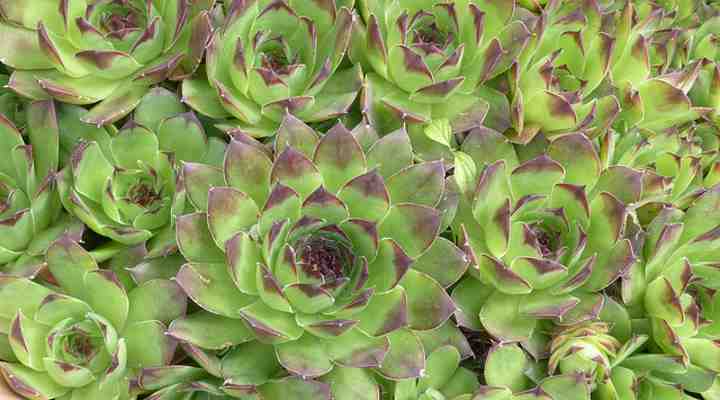
Hens and chicks are small, drought-tolerant succulents that grow in partial to light shade. The attractive succulents are characterized by their fleshy, pointed green leaves with reddish or purple tips. These grow in a dense rosette pattern, forming a beautiful houseplant. Although they generally prefer full sun, hens and chicks can tolerate shade.
A key feature of hens and chicks is their ability to propagate easily. The “hen” is the mother plant, and the “chicks” are small offsets growing around the main plant. You can separate them without problem and replant them in loose, sandy soil to grow new plants.
It’s good to note that the foliage coloration typically requires bright, indirect light for vibrancy.
- Plant Size: 2” to 6” (5 – 15 cm) tall
- Watering Needs: Low
- Sun Exposure: Full sun to partial shade
Christmas Cactus (Schlumbergera x buckleyi)

The Christmas cactus is a popular flowering succulent plant that thrives in partially shaded conditions. The houseplant is known for its colorful tubular flowers and drooping, flattened, segmented stems with scalloped margins. As its name suggests, Christmas cactus blooms in late fall through late winter.
Unlike traditional cacti, Christmas cacti are native to the tropical rainforests of Brazil, where they grow under the forest canopy. Therefore, the succulent plants are well-suited to indoor growing conditions. They prefer partial shade and consistent moisture to thrive. Keep the soil slightly moist but not waterlogged, as overwatering can lead to root rot.
With the proper care, Christmas cacti can produce stunning blooms year after year. The plant requires 12 to 14 hours of complete darkness each night for several weeks to encourage flowering. The deep shade triggers flower buds to form and ensures a vibrant floral display.
- Plant Size: 6” to 12” (15 – 30 cm) tall and 18” to 24” (45 – 60 cm) wide
- Watering Needs: Moderate watering to keep the potting mix evenly moist
- Sun Exposure: Indirect light during the day
Star Cactus (Haworthia retusa)

Star cactus is a compact, eye-catching, tolerant succulent with thick, plump, triangular fleshy leaves forming a star shape. Thriving in dappled shade, the small houseplant has distinctive translucent leaves. Its low growth of up to 4” (10 cm) means it typically grows in the shadow of grasses and other plants.
The star cactus is known for its distinctive star-like appearance when viewed from above. Although tolerant of low-light conditions, bright direct light produces the best leaf colors. It’s also vital to avoid overwatering the plant, as this can lead to root rot.
This succulent is an excellent choice for adding a touch of greenery to your desk, tabletop, or windowsill. Its compact size makes it ideal for small shaded areas.
- Plant Size: 2 to 4 inches (5 to 10 cm) tall
- Watering Needs: Infrequent
- Sun Exposure: Bright, indirect light or partial shade
‘Twilight Zone’ (Gasteraloe)

‘Twilight Zone’ is a striking succulent plant that is one of the most shade-tolerant aloes. It’s a hybrid of the Gasteria and Aloe genera featuring a rosette of dark green leaves covered in white speckles resembling a starry night sky—hence the name “Twilight Zone.”
The ‘Twilight Zone’ plant is perfect for adding beauty to shaded indoor spaces. The clump of pointed, bumpy leaves grows up to 12” (30 cm) tall, and its shape resembles that of a typical aloe vera plant. Partial shade is ideal for best growth; however, the leaves turn almost black in direct sunshine.
- Plant Size: Up to 12” (30 cm) tall
- Watering Needs: Occasional watering only when the soil dries
- Sun Exposure: Partial shade
Haworthiopsis Concolor (Haworthiopsis fasciata ‘Concolor’)

Although bright, indirect light is preferred for ‘Concolor’ succulents, the plants cope well in shaded locations. The succulent plant consists of densely growing bright green succulent spikes covered in raised white spots. Its compact nature and tolerance for low indoor light and drought make it ideal for a small houseplant.
Haworthiopsis ‘Concolor’ grows up to 6” (15 cm) tall and wide. Its rosettes of thick, pointed leaves with rows of dots make it look like the related zebra plant (Haworthiopsis fasciata). The plant is easy to care for and can thrive in various light conditions, making it a versatile houseplant for most rooms in your home.
- Plant Size: 4” to 6” (10 – 15 cm) tall
- Watering Needs: Infrequent watering only when the top layer of soil dries
- Sun Exposure: Low-light, partial shade
Devil’s Backbone (Euphorbia tithymaloides)
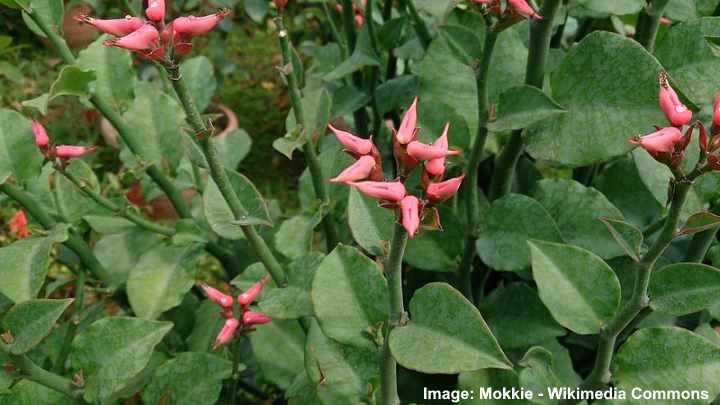
Devil’s backbone is an unusual plant with zig-zag succulent stems that perform well indoors when shaded from direct sunlight. Also known as Redbird Cactus or Jacob’s Ladder, this eye-catching plant has smooth, pointed green leaves growing in pairs and red flowers. As a houseplant, the devil’s backbone grows 2 to 3 ft. (0.6 – 0.9 m) tall.
Devil’s backbone is a perennial shrubby plant that is easy to care for indoors. It thrives in sandy, well-drained soil and is drought-tolerant. Although it can tolerate low light levels, the succulent requires bright, indirect light to thrive. However, it’s important to note that too much sunlight can burn the leaves.
It is also essential to keep this plant away from pets and children, as the milky sap it produces can be toxic if ingested. Even a few drops of the toxic latex substance or root juice can cause severe irritation.
- Plant Size: 2 to 3 ft. (0.6 – 0.9 m) tall
- Watering Needs: Regular watering to keep the soil moist but not soggy
- Sun Exposure: Bright indirect light to partial shade
Ocean Star Hahnii (Sansevieria trifasciata hahnii ‘Ocean Star’)

‘Ocean Star’ is a compact and stylish variety of shade-tolerant snake plants. This plant is perfect for small spaces or as a decorative addition to any room in your home. The Ocean Star Hahnii features short, cylindrical leaves with striking green pattern and yellow margins, giving it a unique and eye-catching appearance.
Like other snake plants, the Ocean Star Hahnii is incredibly easy to care for and can thrive in low-light conditions. It is an excellent choice for beginners looking to add a touch of low-maintenance greenery to indoor spaces. Its watering needs are minimal, as this plant can tolerate periods of drought.
- Plant Size: 6” to 8” (15 – 20 cm) tall
- Watering Needs: Low, allow soil to dry out between waterings
- Sun Exposure: Low light to partial shade
Wax Plant (Hoya carnosa)
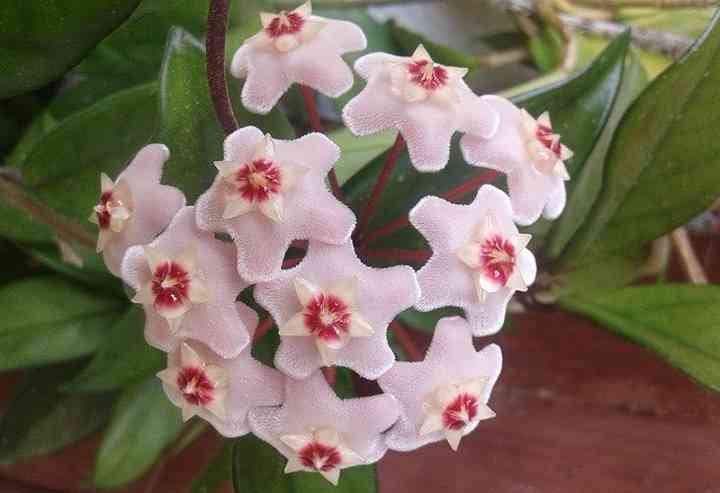
Species of wax plants are popular houseplants for their beautiful waxy leaves, porcelain flowers, and easy care requirements. The non-variegated varieties of hoyas are the most shade-tolerant. Their vining woody stems, and succulent foliage need up to 80 percent protection from direct sunlight. The vining stems can grow up to 4 ft. (1.2 m) long.
Evergreen hoya plants produce flowers if they get plenty of bright light. The flowers are star-shaped, pinkish-white with red centers, and grow in umbrella-like clusters (umbels). The flowers have a honey-like scent and look attractive, dangling among the plant’s evergreen leafy stems.
- Plant Size: 2 to 4 ft. (0.6 – 1.2 m) long
- Watering Needs: Moderate, allow the soil to dry slightly between waterings
- Sun Exposure: Bright, indirect light
Other varieties of low-light hoyas include the following:
- Hoya multiflora
- Hoya obovata
- Hoya pubicalyx
Low-Light Succulents: FAQs
Can a jade plant (Crassula ovata) tolerate low light?
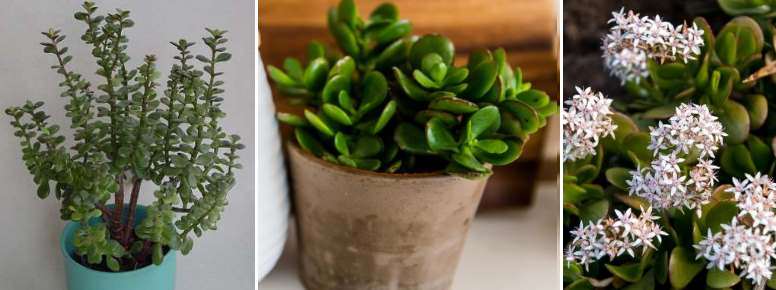
Jade plants thrive in bright, indirect sunlight and may struggle to grow in low-light conditions. Insufficient sunlight can cause the plant to grow leggy with sparse foliage and weak stems. Typically, jade plants need at least four hours of sunlight and are placed near a south-facing window.
How often should I water succulents in low light?
Succulents growing in low light conditions require less frequent watering than those in bright, direct sunlight. Succulents store moisture in their fleshy leaves. Therefore, it’s crucial to let the top layer of soil dry out between waterings. This houseplant watering technique helps prevent overwatering and root rot.
Can I use artificial light for low-light succulents?
Artificial light sources, such as full-spectrum grow lights, can supplement natural light. Most succulents require bright, indirect light to thrive. Even shade-tolerant succulents grow better in brighter light. When growing succulents in a dimly lit room, use the grow lights for 12 hours daily to mimic natural sunlight.
Related articles:
